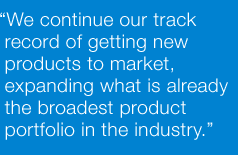|
|
D. Keith Grossman |
||
|
To Our Shareholders |
|||
|
This past year was marked by a number of significant accomplishments, as we successfully pursued our strategy of building a long-term leadership position in our industry and capitalizing on an ever-growing market opportunity. Evidence of our success was reflected by solid revenue growth of 15 percent, increased market presence, significant advances in the third party reimbursement area, new product approvals and major progress in the development of our next-generation technologies. We also strengthened the Company’s financial position with a $144 million convertible debt offering. Despite investing more than $100 million to repurchase approximately 8.5 million shares of stock, we ended 2004 with a strong cash and short-term investments position of $146 million. Our progress in 2004 was exciting and a tribute to the efforts of Thoratec employees and our pioneering customers. We are seeking to create enduring value for Thoratec by becoming a leading developer of technology to treat late-stage heart failure and other cardiovascular disorders. We recognize that achieving success will require a thoughtful, long-term strategy, but we have accomplished much over this past year. Progress in Destination Therapy Because of its importance in fostering the Destination Therapy market, customer reimbursement for this therapy has been a major focus. The fact that average Medicare |
payment for procedures completed by CMS VAD centers has increased from approximately $54,000 to approximately $136,000 in just two years speaks to the success of our efforts and the importance of the procedure in treating late-stage heart failure. The most significant portion of this increase occurred in late 2004, which we believe will have an enabling effect on our business going forward. A second element of our strategy has been to achieve ever- improving patient outcomes through device enhancements, and the dissemination of best practices among clinicians and our centers. We have seen dramatic improvements in the patient experience as evidenced by meaningful declines in adverse events and improved survival rates in our most experienced centers. We believe that the combination of higher reimbursement and these improving patient outcomes is resonating in the marketplace. An increasing number of centers are putting Destination Therapy programs in place and more clinicians are beginning to refer patients for treatment. We think the pace of adoption will continue to reflect that the market is beginning to recognize the advantages of this procedure. A key element of our strategy is increasing the focus on the referring cardiologists who traditionally have treated these patients with other therapies, primarily drugs. Improving patient outcomes are aiding our cause, but we are also embarking on new educational and sales programs as part of an expanded marketing effort to create greater appreciation of the patient experience for those supported by our device. We recognize that we are attempting to overcome many years of established treatment standards, but believe that our efforts are taking hold. Having more current and compelling clinical outcomes data published in peer review journals throughout 2005 will facilitate our efforts in this area. |
© 2005 Thoratec Corporation
|

